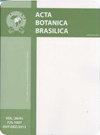鳞片叶子在温带寒冷气候中必不可少吗?标题南美洲温带雨林树种的评价
IF 1.1
4区 生物学
Q4 PLANT SCIENCES
引用次数: 0
摘要
本文章由计算机程序翻译,如有差异,请以英文原文为准。
Are scale leaves essencial in temperate-cold climates? An evaluation in tree species from temperate rainforests of South America
The development of scaly buds (= cataphylls) has been traditionally associated with seasonally cold climates, although only few species from the southern hemisphere were investigated in this regard. The present work focuses on apical and axillary buds of seven tree species native to the South-American Temperate Rainforests (STR). Due to differences in the lineages from which these species derived, high levels of inter-specific variation in bud structure were expected. Apical and axillary buds were dissected under stereomicroscope, and the sizes of their parent shoots were evaluated. Cataphylls and leaf primordia were counted, and the presence of colleters and/or trichomes registered. Both intra-and inter-specific variations in bud structure were found. The apical buds were scaly in two out of seven species, and naked in the other species. Axillary buds were scaly in all but one species. In general terms, larger shoots developed buds with more organs. The presence of colleters (in four species) was not restricted to those buds lacking an outer cover of cataphylls. Further studies should focus on the relevance at a broader scale of colleters and trichomes as protective structures in tree buds.
求助全文
通过发布文献求助,成功后即可免费获取论文全文。
去求助
来源期刊

Acta Botanica Brasilica
PLANT SCIENCES-
CiteScore
2.30
自引率
9.10%
发文量
32
审稿时长
6-12 weeks
期刊介绍:
Experimental, theoretical and applied papers on all aspects of plant (including algae) and fungi biology are welcome. The submitted manuscript or its essential content must not have been published previously or be under consideration for publication elsewhere. Contributions should be substantial, written in high-quality English and show general interest. We expect that the submitted manuscript presents a great novelty in Botany, and this should attract a wide audience. Considering this, case studies are only considered if the narrative and implications are provided to be of general interest. Thus, manuscripts that report aspects of local interest are discouraged unless the implications of the findings are wide-reaching. Manuscripts with agronomic subjects are expected to contain a substantial amount of basic plant biology. Please see below some details for specific area.
 求助内容:
求助内容: 应助结果提醒方式:
应助结果提醒方式:


